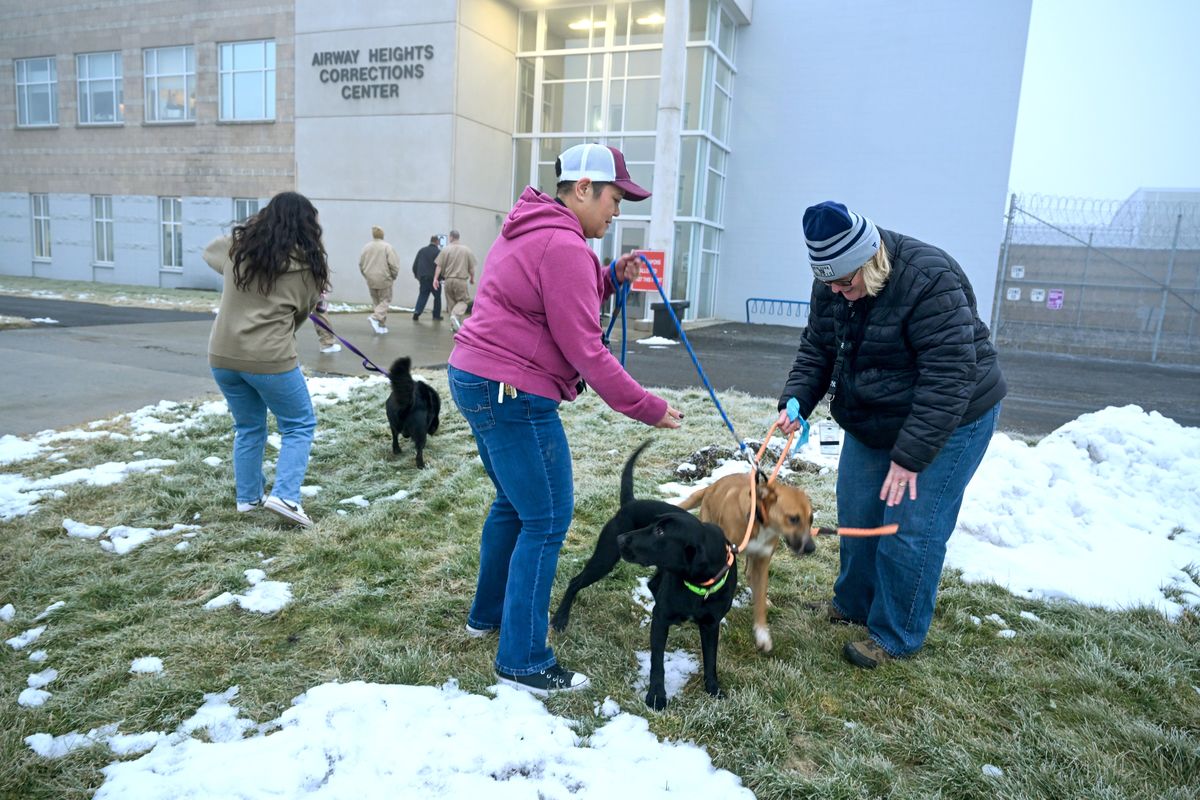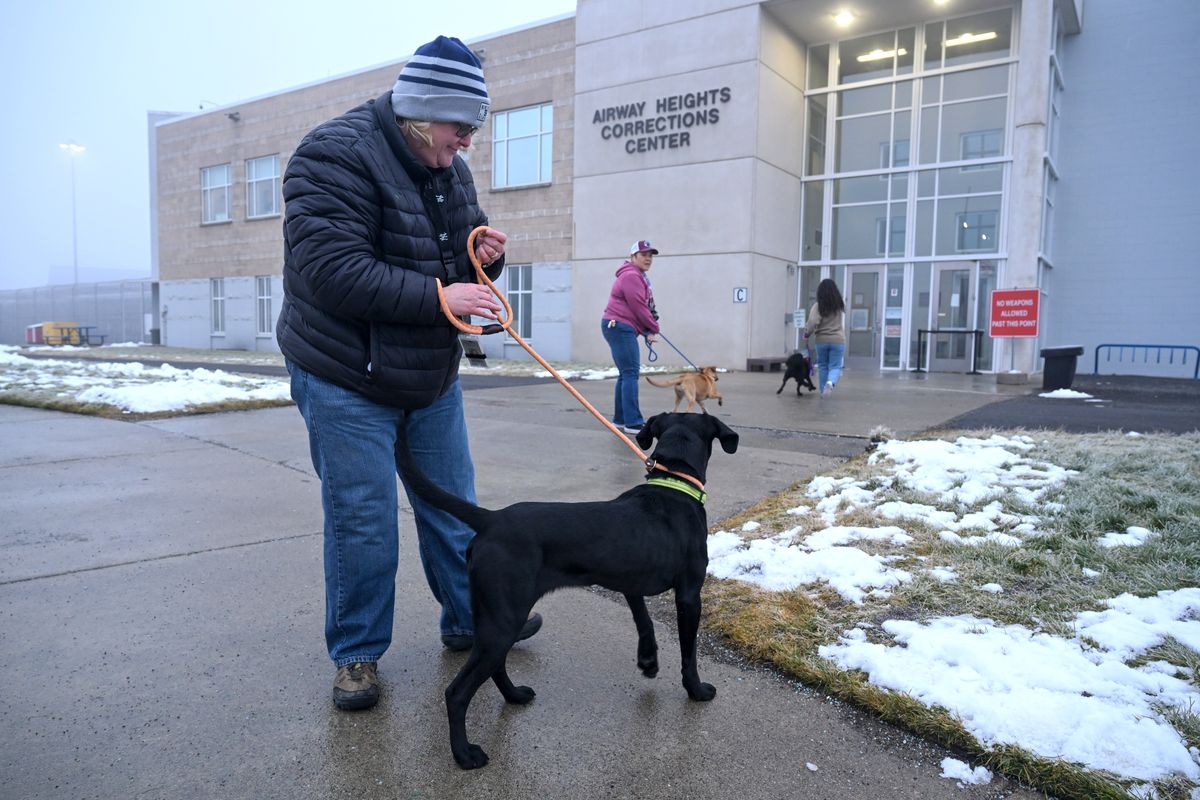‘Our entire sheltering system would be in trouble’: Rising insurance costs strains Spokane-area dog shelters
From left, Cheyenne Smith, Jenniver Catlow, center, and Denise McMains, right, prepare to lead a doge to guide several dogs into the Airway Heights Corrections Center in Airway Heights, Washington Tuesday, Jan. 14, 2025. The dogs are part of a new cohort of animals that will take part in the Pawsitive Prison Program where inmates care for the dogs and help them become socialized. Spokanimal is facing insurance issues over the size of dogs they can care for and adopt out. (Jesse Tinsley/The Spokesman-Review)
Homeowners and motorists aren’t the only ones grappling with rising insurance costs.
In the Inland Northwest, abandoned animals are caught in the middle of coverage woes.
Some of the Inland Northwest’s largest shelters and rescue groups are struggling to find adequate and affordable insurance policies, while also grappling with rising operating costs and capacity strains.
It’s an issue that’s affecting shelters across the country, leading many to adopt more stringent acceptance policies in an effort to lessen the perceived risks to insurance providers, said Mandy Evans, executive director of the Better Together Animal Alliance, an animal welfare organization in Sandpoint that includes a shelter, veterinary services and a food bank.
“Shelters are just a risky business, so we have seen a number of insurance companies just simply say they would not insure sheltering organizations anymore,” Evans said.
Last year, the organization was dropped from its policy despite not filing any claims, Evans said.
“They just said that it was not an area of the business that they wanted to cover anymore,” Evans said.
Evans said the alliance was able to find coverage but is now paying $35,000 annually, more than three times what it paid five years ago.
While the increase hasn’t led to any restrictions for intakes at the facility, similar organizations in Spokane haven’t been as lucky.
The Spokane Humane Society instituted a behavioral assessment into its intake process in late 2023 amid its own challenges with insurance coverage, and after filing two claims for dog bites, Executive Director Kim Reasoner -Morin said.
Last July, the Humane Society’s provider dropped the organization even though the new policy prevents it from bringing in potentially dangerous dogs. Reasoner -Morin said the new insurance policy is about five times more expensive than the last.
“We don’t have any restrictions on breeds or size or weight of dogs, so we’re super fortunate in that regard,” Reasoner -Morin said. “But because we don’t have any restrictions in that department, our insurance went up 566%.”
Dori Peck, director of fellow nonprofit animal group SpokAnimal, declined to speak about the group’s insurance policy.
Peck did share that a weight restriction was put in place last August for the shelter side of their services. SpokAnimal will no longer accept dogs larger than 30 pounds, which Peck said helps “minimize liability issues.”
There’s a lot less risk associated with smaller dogs than larger dogs, Peck said.
“There’s a huge difference,” Peck said. “People are like, ‘That’s not fair, little dogs fight.’ Yes, some do. But honestly, a little tiny chihuahua is not going to hurt you the same way as an 80-pound dog.”
SpokAnimal still cares for some large dogs as part of the Airway Heights Corrections Center’s Pawsitive Dog program, one of several across the state’s prison system that partners shelter dogs with inmates who train them.
Peck said the most recent cohort of four-legged students was dropped off last Tuesday. The shelter will take on large dogs through local or national transfers, as well as owner surrenders, for the program every four to five months, she said.
“They’re adopted before they even graduate from the prison,” Peck said. “We get applications and screen people, so it’s a whole different world with those prison dogs. We’re able to get a few large dogs help that way.”
Rising costs may have myriad causes
Skyrocketing insurance premiums for shelters, rescues and foster groups could be attributed to a combination of factors, including hurricanes and wildfires, landmark legal cases and the rising cost of health care.
Evans argued that insurance companies do not have a complete view of the nuance of the animal welfare industry and the associated risks, when considering providing liability coverage.
The groups and nonprofits that comprise the industry can differ greatly in size and scope, and the risks in an at-home fostering group, for example, compared to a large shelter or rescue are inherently not the same. Evans said many insurance providers simply lump all groups under the same umbrella.
Also part of the math for the providers are the financials, Evans said. The natural disasters that devastated large swaths of the country in recent years led to large payouts to medical patients, homeowners, motorists, boaters and anyone else with insured property.
“The insurance companies are operating in the red, and so that makes them want to assess their risk portfolios,” Evans said. “Shelters are just a risky business.”
Jill Tucker, CEO of the California Animal Welfare Association, said payouts specific to animal shelters are included in those rising costs. Amounts paid out in claims filed by shelters have increased 131% in the past 10 years, according to the association.
There may not have been more claims filed in that time, Tucker said, but the amount has still grown as medical care has become more expensive.
In May 2023, a jury in Los Angeles awarded an animal shelter volunteer who nearly lost her arm in a dog attack $6.8 million, in opposition of the city, as reported by the L.A. Times. Evans and Tucker both pointed to that case, and similar decisions, as a possible origin point of the trepidation among insurers.
Tucker said her organization first caught wind that insurance companies were shying away from member agencies and organizations a couple of years ago.
Since then, CalAnimals has worked with those on both sides of the issue to find a feasible path forward. The organization has held webinars and meetings with insurers to try and educate them about their industry, and with shelters to help them navigate the world of risk and liability, while also providing a number of resources online.
Tucker and her peers are concerned if they aren’t able to get through to insurers, that the industry may pull out of serving animal welfare groups altogether, which could be detrimental to the national system that relies heavily on nonprofits like SpokAnimal and the Spokane Humane Society.
“There is concern that if the nonprofits become uninsurable, and thus just can’t do business at all, our entire sheltering system would be in big trouble,” Tucker said.
Tucker said she’s not sure what a solution to the national issue would be, if there was one. She suggested shelters do what they can to minimize risk by being clear and consistent with their policies in the meantime.
Expenses only part of the challenge
Vicky Nelson, development director for Kootenai County’s Companions Animal Center, said the organization has not had to contend with the same challenges as its peers when it comes to insurance, but it is dealing with capacity issues.
Shelters across the U.S. have seen an influx of surrendered pets in recent years, and owners who scooped up pets during the COVID-19 pandemic have been pointed to as part of the problem. Also contributing to the surrender trend is the “return to normal” changing people’s schedules, as well as economic strains due to rampant inflation and higher costs of living, as reported by the Associated Press.
“Typically, when you see the economy head south, your surrenders and animals that are dropped off goes through the roof,” Nelson said.
Nelson said the center has a long wait list of individuals wanting to surrender their animals to the shelter. Companions Animal Center moved into its newly constructed facility in April 2023, but plans to expand its dog kennels are already underway.
Regarding the policies in the Spokane area, Nelson and Evans both said they worry what effect it may have on the regional system’s capacity. They said they rarely get animals lighter than 30 pounds in North Idaho, and large dogs are harder to get adopted.
“A lot of dogs are coming in and they’re coming in big,” Nelson said. “Even the puppies, we are getting quite a few puppies in, but they’re all big-breed dogs.”
Reasoner -Morin said the Humane Society’s behavioral analysis has not led to a reduction in intakes or adoptions, and that the shelter’s capacity ebbs and flows. It may have little space for new intakes one week, and then a wave of adoptions over the weekend could free up space the next. Staff are constantly monitoring to ensure animals in their care have enough space, access to veterinarians and are moving through the system, she said.
“The other thing is staffing,” Reasoner -Morin said. “So of course you can fill every nook and cranny, but do you have the staffing and the volunteers to feed and walk and clean, so they’re not living in a kennel space for 23 hours out of the day?”
Pet owners should spay or neuter their companions, Peck said, as it’s one of few ways to address overcrowding. She said the three veterinarians on staff at their low-cost clinic are performing between 60 to 70 surgeries a day, and it’s still not enough.
“We’re overrun,” Peck said. “And this is not just Spokane, this is nationwide. Every shelter is drowning that hadn’t been prior to COVID.”
Aside from spaying and neutering, volunteering or donating, Tucker said the most obvious way to help local shelters is through adoptions. The public often underestimates the variety of animals available for adoption on any given day, she said, and groups across the company need help moving animals through the system.
“There’s just such a nice selection of ages and breeds and sizes and temperaments, and staff and volunteers there that help people find the right match,” Tucker said. “The more we can get the animals out, and the more balance we have between the number of animals coming in and leaving, the better we can manage it all.”





